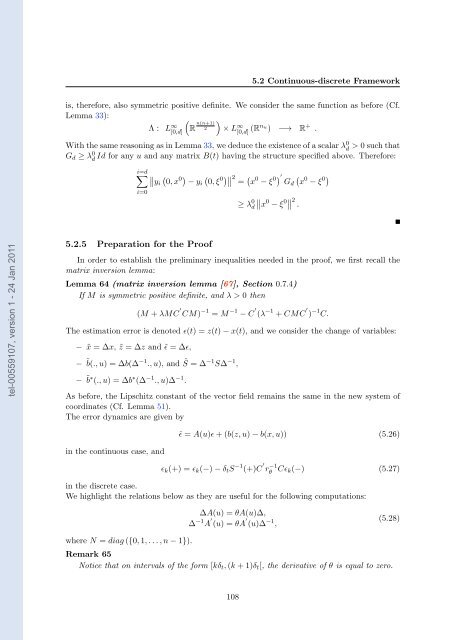Adaptative high-gain extended Kalman filter and applications
Adaptative high-gain extended Kalman filter and applications
Adaptative high-gain extended Kalman filter and applications
Create successful ePaper yourself
Turn your PDF publications into a flip-book with our unique Google optimized e-Paper software.
tel-00559107, version 1 - 24 Jan 2011<br />
5.2 Continuous-discrete Framework<br />
is, therefore, also symmetric positive definite. We consider the same function as before (Cf.<br />
Lemma 33):<br />
Λ : L∞ �<br />
[0,d] R n(n+1) �<br />
2 × L∞ [0,d] (Rnu ) −→ R + .<br />
With the same reasoning as in Lemma 33, we deduce the existence of a scalar λ0 d > 0 such that<br />
Gd ≥ λ0 d Id for any u <strong>and</strong> any matrix B(t) having the structure specified above. Therefore:<br />
�i=d<br />
�<br />
�yi i=0<br />
5.2.5 Preparation for the Proof<br />
� 0<br />
0,x � � 0<br />
− yi 0, ξ �� �2 = � x 0 − ξ 0�′ � 0 0<br />
Gd x − ξ �<br />
≥ λ 0 �<br />
� 0 0<br />
d x − ξ � �2 .<br />
In order to establish the preliminary inequalities needed in the proof, we first recall the<br />
matrix inversion lemma:<br />
Lemma 64 (matrix inversion lemma [67], Section 0.7.4)<br />
If M is symmetric positive definite, <strong>and</strong> λ > 0 then<br />
(M + λMC ′<br />
CM) −1 = M −1 − C ′<br />
(λ −1 + CMC ′<br />
) −1 C.<br />
The estimation error is denoted ɛ(t) =z(t) − x(t), <strong>and</strong> we consider the change of variables:<br />
− ˜x = ∆x, ˜z = ∆z <strong>and</strong> ˜ɛ = ∆ɛ,<br />
− ˜ b(., u) =∆b(∆ −1 ., u), <strong>and</strong> ˜ S = ∆ −1 S∆ −1 ,<br />
− ˜ b ∗ (., u) =∆b ∗ (∆ −1 ., u)∆ −1 .<br />
As before, the Lipschitz constant of the vector field remains the same in the new system of<br />
coordinates (Cf. Lemma 51).<br />
The error dynamics are given by<br />
in the continuous case, <strong>and</strong><br />
˙ɛ = A(u)ɛ +(b(z, u) − b(x, u)) (5.26)<br />
ɛk(+) = ɛk(−) − δtS −1 (+)C ′<br />
r −1<br />
θ Cɛk(−) (5.27)<br />
in the discrete case.<br />
We <strong>high</strong>light the relations below as they are useful for the following computations:<br />
where N = diag ({0, 1, . . . , n − 1}).<br />
∆A(u) =θA(u)∆,<br />
∆−1A ′<br />
(u) =θA ′<br />
(u)∆−1 ,<br />
Remark 65<br />
Notice that on intervals of the form [kδt, (k + 1)δt[, the derivative of θ is equal to zero.<br />
108<br />
(5.28)

















